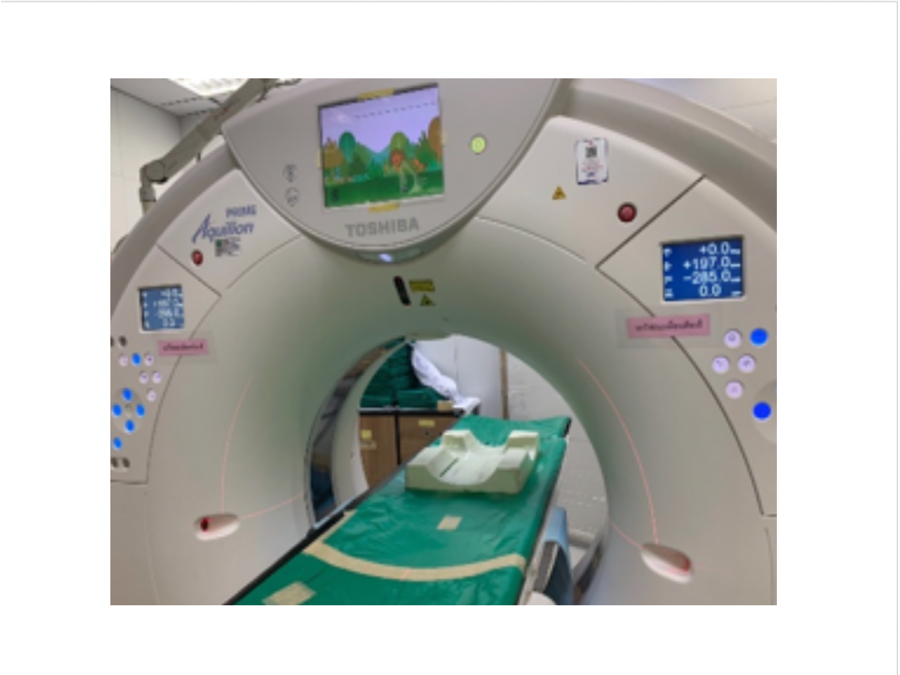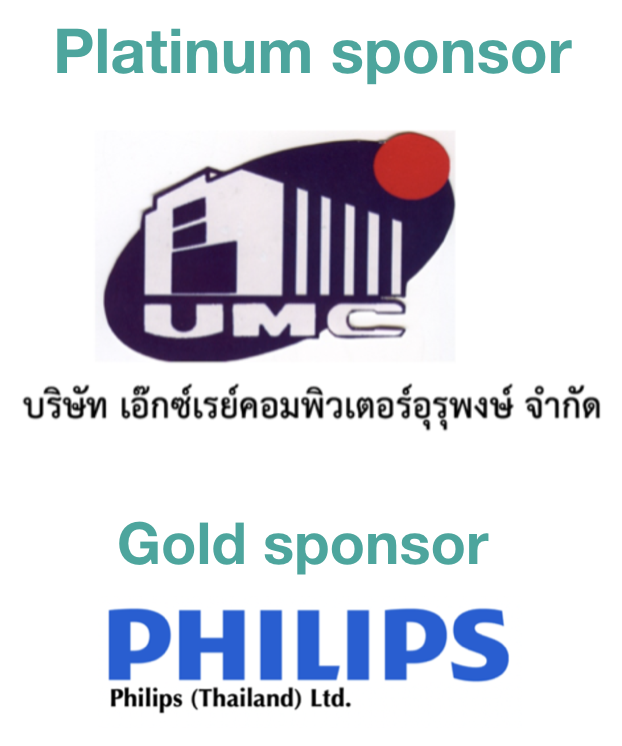การศึกษาคุณสมบัติขอวัสดุ Acrylonitrile butadiene styrene ในการประดิษฐ์อุปกรณ์ยึดตรึงทารกสำหรับการถ่ายเอกซเรย์ บริเวณทรวงอก
คำสำคัญ:
อุปกรณ์ยึดตรึง, อุปกรณ์จัดท่าทารก, การถ่ายภาพรังสีทารกบทคัดย่อ
บทนำ: การถ่ายเอกซเรย์ทรวงอกในทารกทำได้ยากและใช้เวลานาน เนื่องจากทารกจะร้องและดิ้นขณะทำการถ่ายเอกซเรย์ ทำให้ภาพถ่ายทางรังสีคุณภาพไม่ดี เป็นสาเหตุหลักที่ทำให้ต้องถ่ายภาพเอกซเรย์ซ้ำ ทำให้ทารกได้รับปริมาณรังสีเพิ่มขึ้นโดยไม่จำเป็น ผู้วิจัยตระหนักถึงความยุ่งยากในการจัดท่าเอกซเรย์ จึงได้ประดิษฐ์อุปกรณ์ยึดตรึงทารกสำหรับการถ่ายภาพเอกซเรย์บริเวณทรวงอก เพื่อยึดตรึงให้ทารกอยู่นิ่งขณะถ่ายภาพเอกซเรย์
วัตถุประสงค์: เพื่อทดสอบคุณสมบัติของอุปกรณ์ช่วยยึดตรึงทารกที่ทำจากวัสดุ Acrylonitrile butadiene styrene ในการถ่ายภาพเอกซเรย์บริเวณทรวงอก และเพื่อสอบถามความคิดเห็นของบุคลากรต่ออุปกรณ์ช่วยยึดตรึงทารกที่ห้องเอกซเรย์หมายเลข 3 แผนกรังสีวินิจฉัย และหอผู้ป่วยเด็กแรกเกิด Neonatal Moderate Intensive Care Units (NMCU) และ Nursery โรงพยาบาลสงขลานครินทร์
วิธีการศึกษา: อุปกรณ์ยึดตรึงทารกทำจากวัสดุ Acrylonitrile butadiene styrene ซึ่งผ่านการขึ้นรูปให้มีลักษณะโค้งเป็นหลุมตามสรีระทารก โดยใช้ผ้าติดตีนตุ๊กแกเป็นแถบยึดตรึง แล้วนำอุปกรณ์ยึดตรึงทารกมาวัดปริมาณรังสีโดยเครื่องวัดปริมาณรังสี RaySafe X2 Solo และทดสอบความแข็งแรงด้วยระเบียบวิธีไฟไนต์เอลี-เมนต์ (Finite element analysis) นอกจากนี้ยังให้บุคลากร ได้แก่ พยาบาลที่ปฏิบัติงานในหอผู้ป่วยเด็กแรกเกิด และนักรังสีเทคนิคตอบแบบสอบถามความคิดเห็นต่ออุปกรณ์
ผลการศึกษา: จากการเปรียบเทียบปริมาณรังสีเอกซ์ที่ผ่านอากาศและแผ่นพลาสติก Acrylonitrile butadiene styrene (ABS) ที่ผ่านการขึ้นรูปแล้ว พบว่ามีความแตกต่างกันประมาณร้อยละ 5.48 จากการทดสอบความแข็งแรงของอุปกรณ์ยึดตรึงทารกด้วยวิธีไฟไนต์เอลีเมนต์ (Finite element analysis) พบว่าแรงมากสุดที่อุปกรณ์ได้รับในแต่ละกรณี คือ ยกขา, ยกขาและยกแขน 2 ข้าง, ยกขาและยกแขน 1 ข้าง, ยกแขน 2 ข้าง, ยกแขน 1 ข้าง และไม่ยกขาไม่ยกแขน เท่ากับ 2.149, 6.794, 6.374, 6.754, 6.268 และ 2.655 MPa ตามลำดับ จากแบบสอบถามความคิดเห็นต่ออุปกรณ์ยึดตรึงทารก มีความเห็นด้วยอย่างยิ่งในเรื่องโครงสร้างแข็งแรง สามารถรับน้ำหนักทารกได้และอุปกรณ์มีขนาด น้ำหนักเหมาะสมร้อยละ 63.64 รองลงมาคือสามารถใช้งานง่าย สะดวก รวดเร็ว และสามารถนำไปใช้ได้จริงในอนาคตร้อยละ 54.55 และเหมาะกับสรีระทารกสามารถจำกัดการขยับร้อยละ 36.36
สรุปผลการศึกษา: ยึดตรึงทารกสามารถนำไปใช้ได้โดยไม่จำเป็นต้องเพิ่มพารามิเตอร์ที่ใช้ในการถ่ายภาพ (exposure parameter, kVp และ mAs) นอกจากนี้ยังมีความแข็งแรงสามารถทนแรงกระทำของกล้ามเนื้อทารกได้ และได้รับความเห็นด้วยอย่างยิ่งจากบุคลากรในเรื่องโครงสร้างแข็งแรง สามารถรับน้ำหนักทารกได้ และอุปกรณ์มีขนาด น้ำหนักเหมาะสม
Downloads
เอกสารอ้างอิง
American College of Radiology. ACR–SPR–STR Practice Parameter for The Performance of Portable (mobile unit) Chest Radiography [Internet]; 2017 [cited 2019 Sep 26]. Available from: https://www.acr.org/-/media/ACR/Files/Practice- Parameters/Port-Chest-Rad.pdf
Diagnostic Radiology. Radiation Protection [Internet]; 2018 [cited 2019 Sep 24]. Available from: https://med.mahidol.ac.th/radiology/sites/default/files/public/training/Protection2018.pdf
European guidelines on quality criteria for diagnostic radiographic images: In paediatrics. Luxembourg: European Commission; 1996.
เสกสรรค์ ค้าขาย และ ปัญญาคม ลีจันทึก. ปริมาณรังสีที่ผิวผู้ป่วยเด็กจากการถ่ายภาพรังสีทรวงอกที่โรงพยาบาลจักราช จังหวัดนครราชสีมา ปี 2555. วารสารวิจัยและพัฒนาด้านสุขภาพสำนักงานสาธารณสุขจังหวัดนครราชสีมา 2555;1:58-6
Kohda, E., Tsutsumi, Y., Nagamoto, M., Gomi, T., Terada, H., Kawawa, Y. et al. Revisit image control for pediatric chest radiography. Japan Radiological Society 2006;25:60-64.
Mahmoudabadi, A., Moghadam, M. S., Sajjadi, M., Shams, M. and Ameri, L. Improving the quality of positioning and reducing the rotation factor during pediatric portable chest radiography using infant immobilizer. Bali Medical Journal 2018;2:420-425.
งานรังสี กลุ่มวัณโรค กรมควบคุมโรค กระทรวงสาธารณสุข. คู่มือการถ่ายภาพรังสีทรวงอก THE MANUAL OF CHEST RADIOGRAPHY. โรงพิมพ์ราชทัณฑ์; 2546.
ชินา ลออพิพัฒน์ และณัฐภัทร สุวรรณชาตรี. การทดสอบอุปกรณ์ยึดตรึงทารกสำหรับการถ่ายภาพเอกซเรย์บริเวณทรวงอกและช่องท้องในหุ่นจำลอง Testing the pediatric immobilization device for chest and abdomen radiography in Phantom. มหาวิทยาลัยสงขลานครินทร์; 2561.
ปกรณ์ บุราคร. การวิเคราะห์ความแข็งแรงและปรับปรุงโครงสร้างที่นั่งสำหรับรถโดยสารขนาดใหญ่ด้วยระเบียบวิธีไฟไนท์อิลลิเมนต์ Strength analysis and improvement of the seat structure for large passenger vehicles using finite element method. มหาวทิยาลัยเทคโนโลยีสุรนารี; 2556.
พลวัฒน์. FEA (Finite Element Analysis) คืออะไร. [อินเทอร์เน็ต]; 2557 [เข้าถึงเมื่อ 2 เม.ย. 2563]. เข้าถึงได้จาก: http://thai-solidworks simulation.blogspot.com/2014/10/fea-finite-element-analysis.html
พลวัฒน์. ผลลัพธ์ที่ได้จาก Simulation. [อินเทอร์เน็ต]; 2559 [เข้าถึงเมื่อ 8 เม.ย. 2563]. เข้าถึงได้จาก: http://thai-solidworks-simulation.blogspot.com/2016/03/simulation-part-25.html
ฐิตินันท์ จันเส. ประสิทธิภาพของเสื้อถ่ายภาพรังสีสำหรับคุณหนู. งานรังสีวิทยาโรงพยาบาลส่งเสริมสุขภาพ ศูนย์อนามัยที่ 6; 2555.
บุญสม พานิช. ผลการใช้นวัตกรรมหมอนยึดแขน (Fix for film) เพื่อถ่ายภาพรังสีทรวงอกในทารกแรกเกิดใส่เครื่องช่วยหายใจ [อินเทอร์เน็ต]; 2560 [เข้าถึงเมื่อ 25 ก.ย. 2562]. เข้าถึงได้จาก: http://203.155.220.238/csc/attachments/article/189/nurse600202.pdf.
พัชรีย์ ไชยฤกษ์. เตียงถ่ายภาพรังสีทารก. โรงพยาบาลสงขลานครินทร์; 2560.
เพชรากร หาญพานิชย์, บรรจง เขื่อนแก้ว, ศศินันท์ กำขันตี และคณะ. อุปกรณ์ถ่ายภาพรังสีทรวงอกรูปทรงยีราฟ. ศรีนครินทร์เวชสาร 2554;3:163-167.
รพ.พิจิตร จังหวัดพิจิตร. อุปกรณ์ยึดจับเด็กขณะถ่ายภาพรังสีปอด [อินเทอร์เน็ต]; 2562 [เข้าถึงเมื่อ 27 ก.ย. 2562]. เข้าถึงได้จาก: https://www.gotoknow.org/posts/403985

ดาวน์โหลด
เผยแพร่แล้ว
รูปแบบการอ้างอิง
ฉบับ
ประเภทบทความ
สัญญาอนุญาต
บทความที่ได้รับการตีพิมพ์เป็นลิขสิทธิ์ของสมาคมรังสีเทคนิคแห่งประเทศไทย (The Thai Society of Radiological Technologists)
ข้อความที่ปรากฏในบทความแต่ละเรื่องในวารสารวิชาการเล่มนี้เป็นความคิดเห็นส่วนตัวของผู้เขียนแต่ละท่านไม่เกี่ยวข้องกับสมาคมรังสีเทคนิคแห่งประเทศไทยและบุคคลากรท่านอื่น ๆในสมาคม ฯ แต่อย่างใด ความรับผิดชอบองค์ประกอบทั้งหมดของบทความแต่ละเรื่องเป็นของผู้เขียนแต่ละท่าน หากมีความผิดพลาดใดๆ ผู้เขียนแต่ละท่านจะรับผิดชอบบทความของตนเองแต่ผู้เดียว




